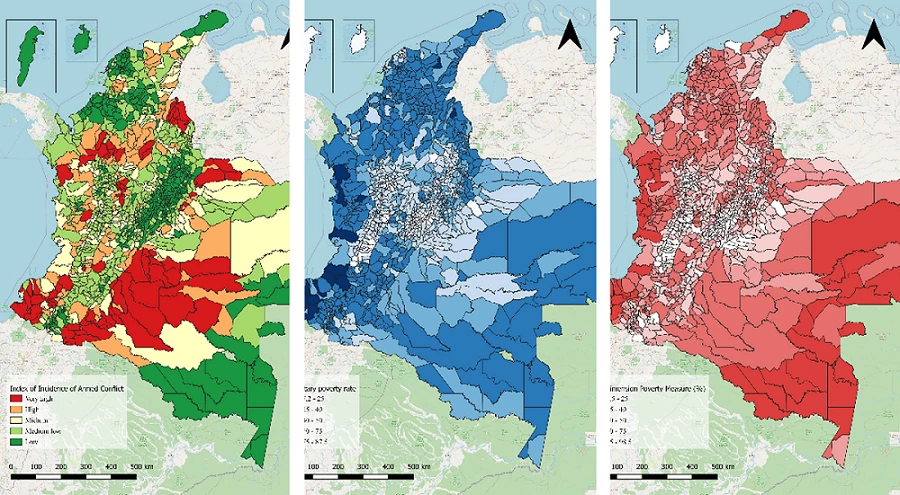
Despite impressive economic growth and development gains over the last two decades, Colombia remains one of the most unequal countries in the world, with significant gaps between major urban centers and rural areas.
Colombia's vast rural regions, which make up 88% of the country's territory, hold enormous untapped potential for development but are facing a range of systemic challenges. Regions like the Pacific, Amazon, Orinoquía, and Guajira have long been afflicted by violence, a structural underinvestment in education, health and infrastructure, and limited law enforcement and government presence, resulting in poverty and extreme deprivation comparable to the poorest regions worldwide. The maps below show an interesting correlation between multidimensional (i.e., housing, food and health/education needs) and monetary poverty (i.e., income), and incidence of conflict in these regions.

Transport connectivity (or lack thereof) plays an important part in the situation. According to the World Economic Forum's Global Competitiveness Report 2019, Colombia ranks 104 out of 141 economies in terms of road quality. Insufficient rural transport infrastructure (limited coverage, poor quality) exacerbates poverty and hinders access to crucial services such as healthcare, education, markets, and basic amenities. In fact, our recent analysis revealed that approximately 10.6 million people in Colombia face low accessibility to services, meaning they are more than 60 minutes away from essential healthcare, education, and public services. Of this population, 63.6% are concentrated in rural departments, with Vichada, Chocó, and Putumayo being particularly affected.
This issue is consistently recognized as a critical bottleneck for closing development gaps between rural and urban areas. Compounding the issue is a limited supply of government services (health, education, enforcement) in rural areas and a lack of capacity and resources to implement comprehensive and sustainable programs.

This reality is all too familiar in Colombia’s Pacific region, where people have been grappling with high poverty rates and limited access to essential public services like water, sanitation, energy, and transport. Illegal and illicit activities also have a significant impact on the local economy. The area is characterized by low accessibility, vast uninhabited areas, and underdevelopment. Boats traveling by sea, along rivers, or across estuaries are the main form of transport to carry both passengers and freight, along with the occasional air service. For residents in the region, this means a lengthy boat ride is often the only way to access hospitals or healthcare services.
To better understand how locals fulfill their mobility needs, we carried out a survey that produced insightful results. For example, a one-way boat trip in Colombia's most isolated regions typically costs between COP 60,000 to COP 140,000, or between 5 and 11 percent of the monthly minimum wage (approximately $13 to $30). Around 35 percent of trips require more than three hours of travel, while about half of them take between and three hours. Some 65 percent of respondents rate trip safety as poor. Transport frequency is low, and many travelers often need to wait for boats to fill up with passengers before starting a journey, adding to the total travel time. The cost and time of travel further challenges individuals’ capacity to generate income, as many individuals in the Pacific region work in informal settings and struggle to earn a minimum wage. Fuel availability is another major problem: fuel is in short supply to begin with and is used in the production of narcotics. This often results in artificially higher costs, scarcity, and week-long disruptions to travel.

In an effort to address connectivity challenges in the Pacific Region, the World Bank and the Government of Colombia (GoC) are implementing Plan Todos Somos PAZcífico, which focuses on building resilient and sustainable dock infrastructure in seven coastal municipalities, along with a signaling system for the southern waterway corridor. Local communities have been directly involved in the design and implementation of the project (in particular women, girls and indigenous communities), promoting accountability and inclusivity. The docks are designed to enhance mobility, catering to the specific needs of local communities and incorporating innovations like solar panels, rainwater collection and cranes for heavy loads. The plan also supports the establishment of rural microenterprises, generating employment opportunities.
The construction of the new docks will bring a significant boost to the economy and overall development of Colombia's Pacific region, benefiting roughly 147,000 people. The docks will improve reliability by extending the available operating window for boats to port and sail, as they are designed to adjust to the critical water level changes in the region (when the tide rises, the water level can rise vertically between 3 and 4.5 meters). The facilities for cargo and passengers will reduce loading and unloading times, allowing for more frequent and efficient services.

Of course, these efforts are not confined to the Pacific region. Everywhere in Colombia, there is a clear sense that better transport infrastructure could unlock significant development gains for rural communities. This vision, reflected in the recently approved National Development Plan, includes programs such as Caminos Comunitarios de la Paz Total, which will upgrade and rehabilitate more than 33,000 kms of rural roads, and the Plan Amazónico de Transporte Intermodal Sostenible (PATIS) to improve the transport infrastructure in the Amazonia Region.
Building on this, the World Bank stands ready to continue working closely with Colombia and support the development of sustainable, comprehensive rural infrastructure programs that will help local communities reach their full potential.




Join the Conversation